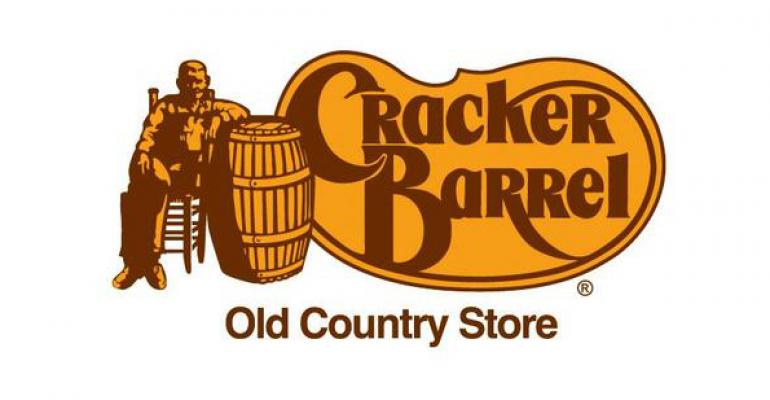Cracker Barrel Old Country Store Inc. is testing ways to increase guest check averages through regional pricing, while simultaneously trimming expenses with technology applications that improve operating margins.
Those were among new initiatives discussed in a conference call with analysts after the Lebanon, Tenn.-based family-dining company on Wednesday reported fourth quarter earnings.
Net income in the Aug. 1-ended fourth quarter rose 14.2 percent to $39.2 million, or $1.63 a share, compared with $34.3 million, or $1.43 per share, in the same quarter last year. Revenue rose 2.8 percent, to $692.7 million, compared with $674.1 in the prior-year quarter.
The 633-unit brand posted a 1.2-percent increase in same-store sales in the fourth quarter, reflecting a 3.1-percent rise in average check and a 1.9-percent decline in traffic.
Stephen Anderson, a senior restaurant analyst with Miller Tabak + Co. LLC, said in a research note that “comps did not accelerate beyond the 2-percent level during the quarter as we had expected them to do. We think one reason for this was that gasoline prices peaked in July nationwide, which may have dampened travel, but as the gasoline price decline accelerated through August and September, we think [Cracker Barrel’s] same-restaurant sales since have made a run toward at least a 2.5-percent pace.”
To help increase average guest checks, Cracker Barrel has begun testing “geographic pricing tiers“ in one market and plans to expand the program.
“Through market and competitive research, we believe that there are select opportunities to offer geographic pricing tiers without negatively impacting guest check or future-visit intent,” said Sandra B. Cochran, president and chief executive of Cracker Barrel, on the call.
Lawrence E. Hyatt, Cracker Barrel’s chief financial officer, said on the call that the test of regional pricing started last week, adding that “we don’t have much of a preliminary read yet.”
The regional-price initiative is built into the company’s guidance of same-store sales increases of two to three percent in 2015, Hyatt added.
“We have baked into our guidance the expectation that the test, if successful, will be implemented gradually over the course of the 2015 fiscal year, so the impact is likely to be felt more in the back half of the year than in the front half,” he said.
Christopher A. Clavarra, Cracker Barrel’s senior vice president for marketing, said guest checks have generally been stable. “We’re not seeing a lot of trading behavior up or down,” Clavarra said. “The mix is relatively stable. We did enjoy in the Q[uarter] higher checks due to our promotional offerings.” Promotional offerings make up about 10 percent of sales, he added.
Cochran also said Cracker Barrel is testing ways to use new applications of technology to improve store operating margins and produce savings of about $50 million over the next three years, including what she described as a “plate reduction initiative.”
“Currently we have nearly 1 billion employee touches to dishes each year,” Cochran said. “We have identified an ability to simplify and consolidate our use of plates by just over 20 percent. Reducing the dish count directly translates into driving dish productivity. The initiative is expected to reduce dish room labor, chemical usage costs and dish replacement expenses.”
The dish-reduction initiative is underway in one of Cracker Barrel’s operating regions, she said, and it has “received positive feedback from both our operators and our guests and implementation is expected to be complete by end of the second quarter.”
In addition, Cracker Barrel is employing a dining-room management system to optimize wait lists and seating processes, Cochran said.
Each Cracker Barrel store sees an average 1,000 guests per day, Cochran said. “This can lead to long wait times and the need for additional host employees during our peak periods,” she said.
The new dining-room management system reduces host labor hours without impacting the guest experience, she said, and it improves through-put by increasing capacity and reducing the number of potential guests who walk away during wait times.
The company is also transitioning to cost-saving light-emitting diode bulbs across much of its system, Cochran said.
In addition to those initiatives, Cochran said Cracker Barrel is working on a new so-called “fusion” prototype store, which will be among the six to seven new stores planned for fiscal 2015.
“The fusion model allows us to re-engineer processes, to reduce initial costs, create a more efficient design for our new stores and evolve the brand,” she said. Morganton, N.C., will be the first location for the fusion prototype, and the CEO said it is in the final stages of design.
Contact Ron Ruggless at [email protected]
Follow him on Twitter: @RonRuggless

